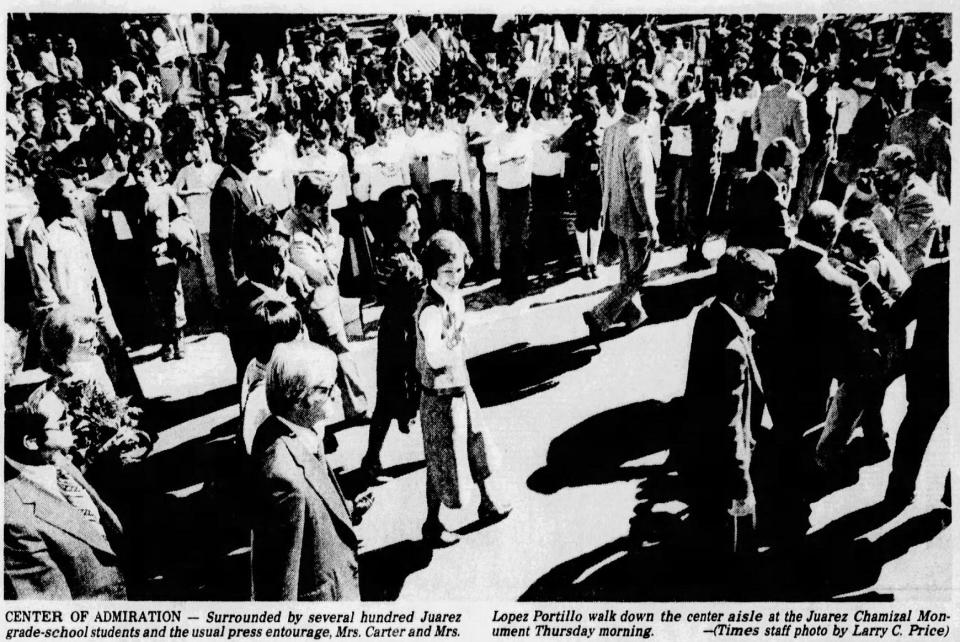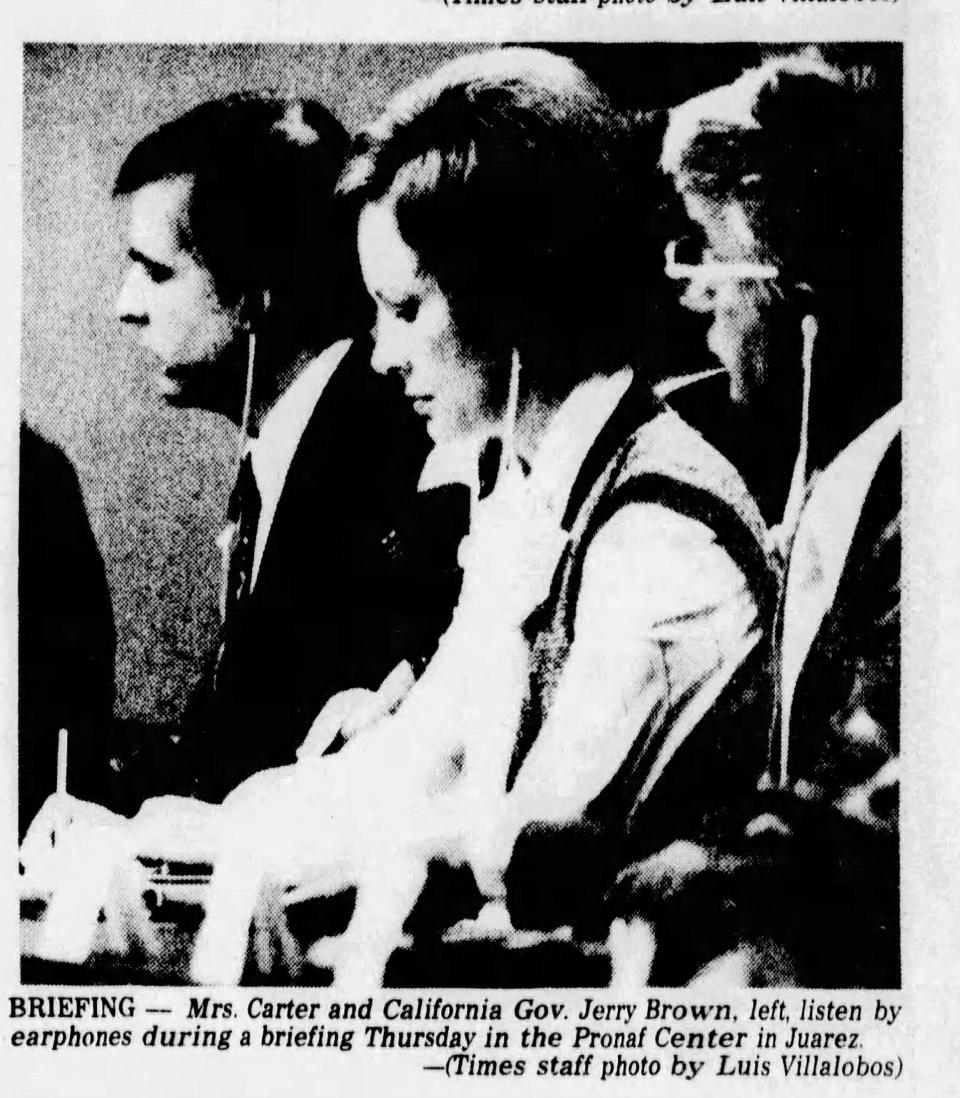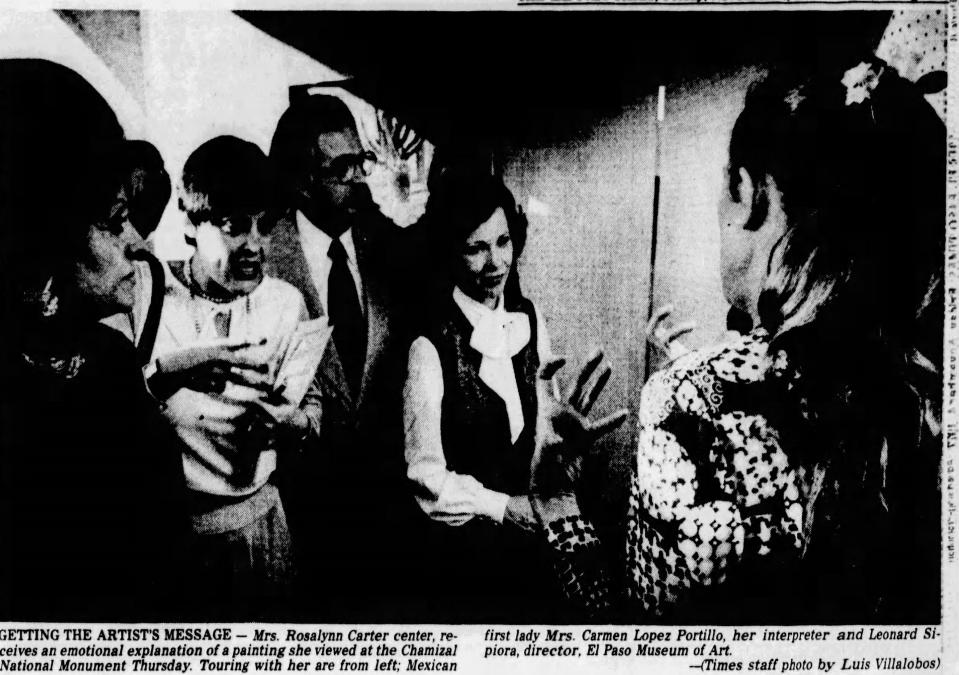El Paso, Juárez welcome First Lady Rosalynn Carter in 1977: A look back at visit's highlights
- Oops!Something went wrong.Please try again later.
- Oops!Something went wrong.Please try again later.
- Oops!Something went wrong.Please try again later.
- Oops!Something went wrong.Please try again later.
The Carter Center confirmed Monday former First Lady Rosalynn Carter died Nov. 19, at 2:10 p.m. at her home in Plains, Georgia, at the age of 96.
Carter visited El Paso and Juárez Nov. 4, 1977, where she met with Mexico's First Lady Carmen Romano de Lopez Portillo in a first-ever meeting of the first wives of presidents of the U.S. and Mexico at the border.
This Nov. 4, 1977, El Paso Times article by Carey Gelernter describes the events of the first lady's visit to the border.

Culture Packs First Ladies’ Day
The whirlwind visit of the first ladies of the United States and Mexico Wednesday – a hectic dash from airport to bridge to Mexico’s Chamizal to the Pronaf to El Paso’s Chamizal Memorial provided a contrast in style of two cultures and two sides of the border.
By 6 Thursday evening, Mrs. Rosalynn Carter was boarding her plane to New Orleans, where she will attend a meeting on mental health, and Mrs. Carmen Romano de Lopez Portillo was ready to get a night’s rest before flying to Hermosillo to dedicate a hospital.
Still, there was enough time for the first ladies to exchange a show of goodwill, long with the niceties, ceremonies and miles.
And there was a chance for dignitaries from both countries to meet their counterparts and, as one member of Mrs. Carter’s official party said, “Exchange cards, so you know who to get into contact with when you go to Washington or Mexico City, respectively.” The border contrast was evident first in the way El Paso and Juárez treated the occasion, billed as a “historic first.”
El Paso takes visit in stride
Perhaps because most of the day’s activities were centered in Juárez, and the one El Paso event, a concert and art exhibit at Chamizal Memorial, was limited to invited guests only. El Pasoans seemed to take the visit in stride.
Mrs. Carter was greeted at El Paso’s Air Transit Terminal by a friendly but fairly subdued crowd of about 100 persons at about 11 Thursday morning.
After she descended from her Air Force jet, followed by her official party of dignitaries, Mayor Ray Salazar presented her with the city’s Conquistador Award. She also got a key to the city.
Mrs. Carter, dressed demurely in a beige bow-tie blouse and a brown and white matching vest and full skirt, accepted a bouquet of red roses from Mrs. Salazar, and greeted other local dignitaries.
A troop of pig-tailed Brownies from Eastwood Knolls School gave Mrs. Carter a corsage of daisies and a Rio Grand Girl Scout Council shoulder patch for daughter Amy.
She then shook hands with the crowd that pressed against the security barricade.
More: El Paso history 1917: Mexican train dynamited by Pancho Villa band
'Bienvenidos Mrs. Lopez Portillo, Welcome Mrs. Carter'
Then Mrs. Carter was quickly swept into a limousine. Other dignitaries filed into a VIP bus and Civic Center van, which followed three police cars, four staff cars, and two press buses in a motorcade to the bridge.
Since the route to Juárez is straight freeway, there were few El Pasoans to cheer her on. But in Zavala Elementary School, youngsters pressed against the school’s chain link fence waving and shouting. Hanging out of the school’s windows was a huge hand-painted paper banner reading, “Bienvenidos Mrs. Lopez Portillo, Welcome Mrs. Carter.”
On the Mexican side of the bridge, however, the mood was one of much greater festivity. The Bridge of the Americas was lined on both sides with Mexican schoolchildren, who had a holiday for the occasion. Dressed in their green, red, and maroon uniforms, waving U.S. and Mexican flags, and carrying posters bearing the photos of the first ladies, they presented a riot of color.
More: When is Rosalynn Carter's funeral? Here's a schedule of events honoring the former first lady
Mrs. Carter met Mrs. Lopez Portillo at the crest of the Bridge of The Americas, where a throng was already waiting. The women exchanged a few words, and then it was quickly back to the limousines and buses.
In contrast to Mrs. Carter’s understated suit and hairdo, the Mexican First Lay was wearing vivid blue eye shadow and dangling gold earrings, a black print dress highlighted with orange an gray, and her black hair was piled high, bouffant-style.

Next stop Mexico’s Chamizal Park
Mexico’s Chamizal Park was the next stop, and it was jammed by a crowd dominated by schoolchildren.
In the park, the dignitaries crossed a footbridge leading into a small area at the center of the park’s elaborate fountain, ringed by gray stone monoliths bearing the name of each Mexican state, specially decked out in flags of both nations. Standing in the center of the fountain plaza, the dignitaries were separated from the crowd by the fountains’ reflecting pool.
Mrs. Lopez Portillo spoke first. She cited the Chamizal settlement 10 years ago as “another of the repeated acts of brotherhood that we must multiply in order to strengthen our ties.”
Speaking in Spanish, she termed the meeting with Mrs. Carter “an affectionate and meaningful meeting between two women who are friends, citizens of neighboring countries that are linked not only by their common borders but also by the important considerations of mutual respect, equitable treatment, and legitimate aspirations for progress.
More: El Pasoan Raymond Telles was first Mexican American mayor of a major Southwestern U.S. city
'Una buena amiga mia'
Mrs. Carter began her brief address in simple Spanish with a heavy Georgia accent, then switched to English. She called the Mexican first lady “una buena amiga mia,” and called attention to the Chamizal settlement as an example of how “difficulties between neighbors could be cleared up through wisdom, good will, and understanding.”
After the Chamizal ceremony, the first ladies were swept on to the Pronaf, where a crowd of about 2,000 were packed into an auditorium awaiting them.
The invitation–only throng consisted mostly of older, well-dressed Mexicans, and a contingent of military officers.
Calling the border “the skin of Mexico,” Mrs. Lopez Portillo said “In other words, what happens to our skin will be seen and felt by those outside as well as those inside Mexico. I hope inhabitants of both sides of the border participate actively in the new era of rapprochement between both countries. This new era is symbolized by the first meeting of wives of presidents of the U.S. and Mexico at the border.”
The dignitaries of both countries sat in a semi-circle on the stage decorated in red, green and white – the colors of the Mexican flag. The red backdrops were covered with hug slogans in white lettering – “Social activities motivate man to continue in the common struggle.”
The two first ladies sat side-by-side in the center of the group, with California Gov. Jerry Brown to Mrs. Carter’s right.
More: Border fee dispute with Mexico led El Paso to issue ID cards in 1921
Standing ovation
In an address which won a standing ovation, Mrs. Lopez Portillo argued that the border region offered Mexico a unique opportunity to display its best features to the rest of the world.
Because men and women from all over the nation have come to the border, Mrs. Lopez Portillo said the region could present itself as a proud sample of the mosaic of Mexican traditions.”
She also noted that “the population increase on the border requires a substantial extension of government and community action.”
We intend to promote the improvement of the living standard of the border communities,” Mrs. Lopez Portillo said.
Both first ladies are known as “active” presidential wives, and a film on Mrs. Lopez Portillo’s activities as the head of the Fundo Nacional Para Actividades Sociales was shown on two screens simultaneously.
FONAPS, whose emblem was blazoned all over Juárez streets, on T-shirts sported by many school children, and on wall murals freshly painted, is a social, health and cultural organization started by Mrs. Lopez Portillo in January 1977.
Also speaking at the Pronaf auditorium were Mexico’s minister of public education, Porfirio Munoz Ledo, and Secretary of Tourism Guillermo Rossell de la Lama. Mrs. Carter did not make any remarks.
After a luncheon at Juárez's Fiesta Real Hotel, where the first ladies were treated to a performance of the Ballet Folklorico de Mexico, the official parties stopped to view the special “Esto es Mexico” exhibit at the Museum of Art and History.

U.S.’s border culture accomplishments
By this time about an hour behind schedule, the motorcade wended its way back across the border for a music-art-and sangria celebration at El Paso’s Chamizal Memorial.
There, Mrs. Carter had a chance to tour some of the U.S.’s border culture accomplishments, which she listed as the development by the Commerce Department, in conjunction with the Southwest Border Commission and Mexico’s tourism department, of publicity materials outlining the attraction of the border; the sponsoring by the State Department of seminars on the conditions of the border, and problems of an interdependent economy; 20 Health, Education and Welfare Department centers emphasizing bilingual, bicultural education for migrant children; Project Bravo centers, which aid 22 percent of El Paso County in legal matters, to get food stamps, in drug rehabilitation, and other services; National Endowment of the Humanities plans for panels and lectures in both countries, to create public dialogue about border problems; and workshops and seminars sponsored the National Endowment of the Arts.
Mrs. Carter then presented Mrs. Lopez Portillo with a dulcimer, which she said was handcrafted by a man in Tennessee. “Since you’re a musician, I thought you might enjoy this,” she said, explaining that the dulcimer is an old American instrument which is being rediscovered.
In her first halting words of English of the trip, Mrs. Lopez Portillo thanked her and greeted the crowd of several hundred.
After a brief tour of the small art exhibit housed under a bright yellow tent and short performances by a brass quintet from the Dallas Symphony and piano recital by Jeffrey Swan, a Van-Cliburn finalist, the official bi-national tour of the first ladies was over.
Back at the El Paso airport, a small crowd was gathering to see Mrs. Carter off.
Trish Long may be reached at tlong@elpasotimes.com or 915-546-6179.
This article originally appeared on El Paso Times: First Lady Rosalynn Carter visits El Paso, Juárez in 1977: Trish Long

